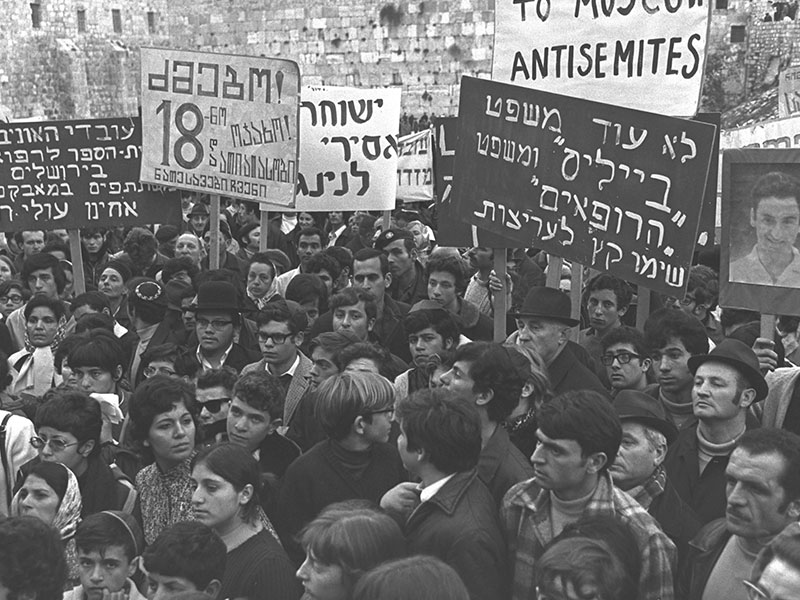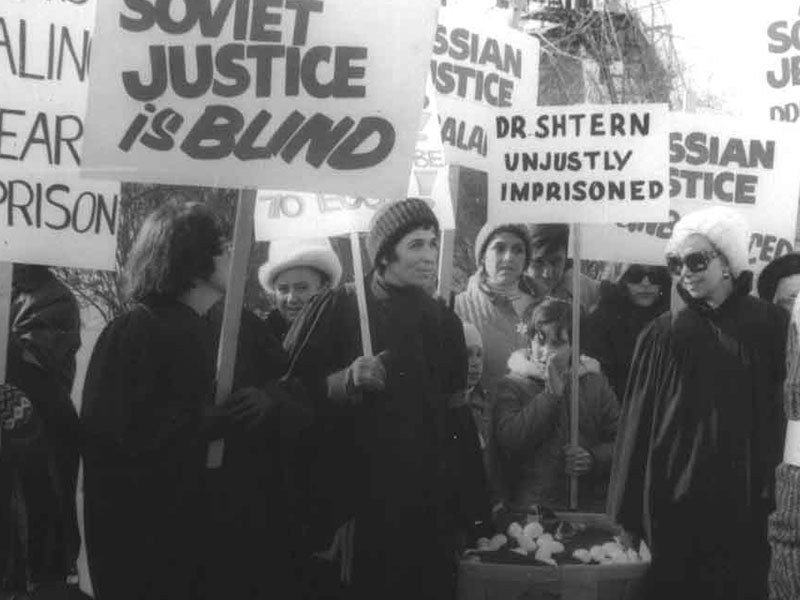To celebrate Chanukah, The CJN is running a series, eight miracles for eight days. In this instalment, Rabbi Yoseph Y. Zaltzman looks at the rescue of Soviet Jews.
The term Soviet Jewry is an oxymoron. According to the normal rules of history, there should be no such thing. By that logic there should be no such thing as the Jewish people either for that matter – thankfully our people’s very existence and everything about it transcends logic. But in Soviet Jewry we see the story of survival against all odds, the miracle of light persevering against the worst kind of darkness, play out not over thousands of years, but over the course of a single century. It is a fitting story to share as we light the Chanukah menorah and contemplate the significance of these special lights flickering in the darkness, illuminating the cold winter nights.
Beginning in 1917, the Communist party wrested control of the Russian Empire from the czarist regime in a revolution and bloody civil war that brought death and suffering to millions of citizens. Following the revolution, the Communist party’s Yevsekzia (“Jewish Section”) embarked on a ruthless war against Judaism. Schools, synagogues and religious institutions were shut down. Religious leaders were imprisoned, and many were summarily shot in the underground execution chambers of the secret police.
To appreciate its significance we have to realize that about half of the Jews in the world lived in the former Soviet Union (FSU). Life under communism was one of the worst eras of persecution and suffering for our people. It was an extended period of darkness and trauma, with anxiety and danger lurking around every corner. People were constantly paranoid and fearing for their lives. But it bore some of our people’s greatest fruits. Our sages teach that the olive only produces oil when it is crushed. There is something about the pressure that extracts something uniquely luminous and pure. It is also the time and place in which I grew up, and I remember living with the constant fear and anxiety that I could be caught doing something “counter-revolutionary,” something Jewish.
In Soviet Jewry we see the story of survival against all odds.
But instead of focusing on the details of Communist brutality and the difficulties of life in the FSU, including the stories of my own family, I will explore something much more instructive and relevant to us today: what is it that enabled Soviet Jewry to survive?
Among all the historical accounts and personal stories, two things stand out: The incredible dedication, self-sacrifice and pure faith of those who stood their ground by keeping Jewish life alive in the FSU, and the unbelievable Divine Providence that accompanied the world events surrounding Soviet Jewry at every turn. I’d like to share some examples of each.
In 1927, the sixth Lubavitcher Rebbe, Rabbi Yoseph Y. Schneersohn (known in Chabad as the previous Rebbe or the Rebbe Rayatz, and was Rebbe from 1920-1950), arranged a Purim gathering in Moscow. He knew that KGB spies connected to the Yevsekzia were present in the room. Nevertheless, the Rebbe publicly proclaimed at the gathering that, without compromise and regardless of the sacrifice it demands, Jewish children must receive a Jewish education. It’s hard to describe the magnitude of this statement; it went contrary to everything the Communists stood for and demanded and was considered a counter-revolutionary act. The Rebbe was actually arrested shortly thereafter for his role in strengthening and preserving Judaism in the FSU and was sentenced to death by firing squad. Miraculously, in an unprecedented move, his sentence was reduced to 10 years in Siberian exile, and ultimately commuted on the condition that he leave the Soviet Union.

It was this spirit of defiance and self-sacrifice that infused and inspired Chassidim in the Soviet Union, including in my own family, as well as in many other Jews. They engaged in underground activities and formed networks to keep Judaism alive and strong, no matter what. There was even a famous “blood oath” that was taken by a quorum of 10 Chassidim to fight for the survival of Judaism until their last drop of blood. It definitely wasn’t easy. People suffered. Activists were persecuted, fired from their jobs, arrested; sent to forced labour camps and exile colonies in northern Siberia and other far-flung corners of the Soviet Union. And those are the ones who managed to stay alive. This era formed dozens of legends – strong-willed, scrappy survivors whose faith in their cause was unshakable.
One such legend was Rabbi Boruch Mordechai Lifshitz, affectionately known as Reb Mottel Der Shochet, who was actually born just a few months before the revolution and lived until the age of 97.
He was one of the few who was willing and able to perform brit milahs (ritual circumcisions) in Moscow. At one such brit, as everyone was waiting for Reb Mottel to arrive, there was a sudden and loud banging at the door. It was a policeman. Apparently, the authorities had caught wind that there was a Jewish gathering taking place, and were looking to investigate. A brit milah, of course, was completely illegal. The participants insisted they were merely celebrating a birthday, but the policeman insisted on inspecting everyone’s identity cards, finally leaving after almost an hour. But the police remained outside, detaining anyone who attempted to enter the apartment. In those days there was no way to warn people to stay away. All of a sudden, Reb Mottel appeared, covered in plaster. On his way to the apartment, he saw the policeman, so he jumped behind a pile of plaster to hide. He then slipped into the apartment and performed the brit.
This era formed dozens of legends – strong-willed, scrappy survivors whose faith in their cause was unshakable.
In addition to the incredible self-sacrifice of Jews in the Soviet Union, there was a tremendous amount of Divine Providence in the activities, both public and behind the scenes, surrounding efforts to free Soviet Jews. In the early 1970s, thanks to various campaigns and covert contacts, the number of Jews granted exit visas steadily increased. Nevertheless, protests continued alongside a campaign for the United States Congress to link Soviet economic interests to Jewish immigration. The seventh Lubavitcher Rebbe, Rabbi Menachem M. Schneerson (who became Rebbe in 1950), insisted that such activism only antagonized Soviet officials and would ultimately prove counter-productive. In 1973, 35,000 Jews were allowed to leave Russia. But in 1974 they retaliated against U.S. economic pressure with a severe crackdown on Jewish emigration. The U.S. policy continued under successive administrations, and by 1982 Soviet Jewish emigration had slowed to a near halt.
READ: JAM STRENGTHENS RUSSIAN-SPEAKING JEWISH COMMUNITY
In the summer of 1983, the Rebbe publicly appealed to the president of the United States to act on behalf of the millions of Jews still behind the Iron Curtain. He warned that “noise and propaganda” led to “opposition and stubbornness,” and advised that human rights “should not be linked with other matters.” The Rebbe used his influence to cause a shift away from public campaigns and public protests, and even had some major rallies cancelled, a move that created much controversy. But the results were clear and immediate. The number of Jews allowed to leave increased from 7,776 to 19,343. In 1990, the number of Jews released to live in freedom was over two hundred thousand.
The Rebbe was also concerned about life after communism. He recognized the Jewish movement in the Soviet Union as a spiritual reawakening, which political emancipation alone could not satisfy. Chabad representatives in Israel and America not only developed new housing projects but also established religious, educational and cultural institutions. Our own Jewish Russian Community of Ontario, which the Rebbe himself set in motion when he sent my wife and me to Toronto as his emissaries in 1980, is one such organization. And there are dozens more, serving hundreds of thousands of former Soviet Jews around the world. The Rebbe also dispatched emissaries to accommodate the spiritual and material needs of those Jews who remained in the former Soviet Union, ensuring that Russian Jewry would endure not only in body but also in soul. Today Chabad serves more than 200 communities across Russia.
READ: JEWSKI ENGAGES IN RUSSIAN-SPEAKING JEWS ON CAMPUS
All of this would not be possible without the co-operation and support of a young non-Jewish boy who grew up in St. Petersburg. The boy had poor parents who were barely home, and a neighbouring chassidic Jewish family would invite him over. The father was a professor who helped him with his homework, and they also invited him for the Friday night Shabbat meals. The family left a big impression on him. He would later describe that the level of harmony, caring and love he witnessed in that home was unique, nothing he had ever experienced, and something worth aspiring to. Many years later, the young boy became the vice-mayor of St. Petersburg, and used his influence to affect the opening of the first Jewish school there. That boy was Vladimir Putin, the long-serving president of Russia, and perhaps the greatest factor in the successful revival of Jewish life in Russia today. What an amazing example of Divine Providence serendipitously setting up the future renaissance of Jewish life in the FSU by placing the future president in the lap of a Jewish family as a young boy!
This is a very short version of a very long and detailed story. It’s hard to imagine the mindset and courage, with which the previous Lubavitcher Rebbe, Reb Mottel and others lived. This power of self-sacrifice was the driving force of the survival of Soviet Jewry and of our people throughout history. I sometimes wonder – in fact, I often feel – that when circumstances are more ideas and less demanding of sacrifice, do we somehow lose that power? I think we have to recognize that though the challenges to Judaism and the Jewish people may, on the surface, seem less existential today than they were then, they nonetheless threaten our survival as a unique people.
So though we can today proudly proclaim and express our Jewishness, and live it above ground, we cannot be satisfied with mere survival. We should harness the empowering capacity for self-sacrifice and the miraculous Divine Providence inherent in our people’s destiny to achieve all that we are put on this earth to accomplish – for our people and for all humanity.





